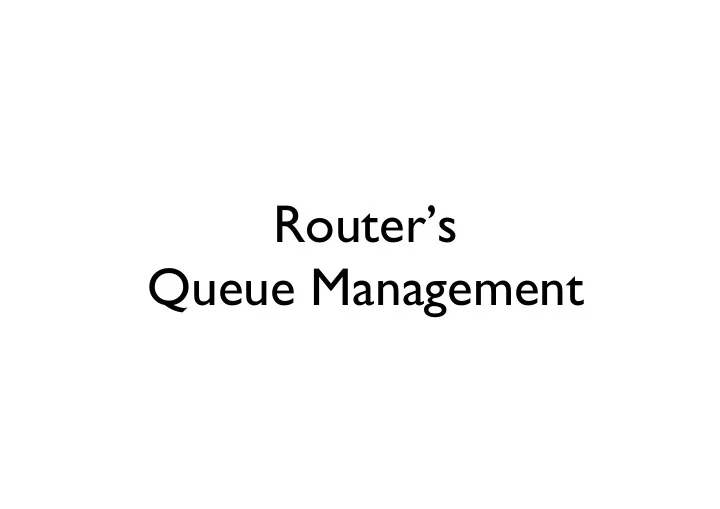

Router’s Queue Management
Manages sharing of (i) buffer space (ii) bandwidth
Q1: Which packet to drop when queue is full?
Q2: Which packet to send next?
FIFO + Drop Tail
Keep a single queue
Answer to Q1: Drop arriving packets when queue is full
Answer to Q2: Send the packet at head of queue
Round Robin
One queue per flow
Answer to Q1: Drop arriving packets from flow i when queue i is full
Answer to Q2: Each flow takes turn -- send the packet at the head of the queues in a round robin manner.
Advantages of FIFO and Drop Tail
Simple to implement
Scale well (no per-connection states)
Reduce delay for a bursty connection (e.g. VoIP)
Problems with FIFO and Drop Tail
Problem 1 Baised againts bursty traffic burstiness increases changes that the queue will overflow
Problem 2 Global synchronization connection reduces their windows simultaneously, lowering utilization.
Problem 3 Queue size higher bandwidth needs longer queue, increasing delay. TCP tries to keep the queue full
Problem 4 No isolation against unresponsive flows
Random Drop
Keep a single queue
Answer to Q1: Drop random packet in the queue when queue is full
Answer to Q2: Send the packet at head of queue
No bias against bursty traffic -- bursty arrival causes random packets to be dropped.
Flows with higher rate occupies more buffer spaces, have more chance to be dropped.
Signal flows that is congesting the network to slow down.
Random drop recovers from congestion (full queue) by dropping packets.
Early Random Drop
Answer to Q1: Drop arriving packet randomly if queue is longer than a threshold
Random drop avoid congestion (full queue) by dropping packets before queue is full.
RED Random Early Detection
Answer to Q1: Drop arriving packet randomly if average queue length is above than a threshold
Differences 1: Use average queue length instead of instantaneous length to absorb transient congestions.
Differences 2: Dropping probability should change dynamically depending on queue length.
Dropping Probability 1 Average Queue Length
foreach incoming packet X calc average queue length if min th < average < max th calc p drop X with probability p else if average > max th drop X
(Instead of dropping packets, we can also set the ECN bit to indicate congestion)
How to calculate average queue length? How to calculate drop probability How to set thresholds?
We can use exponentially weighted average. On every packet arrival:
Large w q : A burst of packets will cause avg to increase too fast, hit the max threshold Small w q : avg increases too slowly and we are unable to detect initial stage of congestions.
We can use exponentially weighted average. On every packet arrival:
We can use exponentially weighted average. On every packet arrival:
What if q drops to zero and no packet arrives? m is a function of period when queue is empty
How to calculate average queue length? How to calculate drop probability How to set thresholds?
Dropping Probability 1 p max Average Queue Length min th max th
How to calculate average queue length? How to calculate drop probability How to set thresholds?
max th - min th should be sufficiently large otherwise average queue size can oscillate beyond max th “need more research” for optimal average queue size.
Advantages of RED
No bias against bursty flows Less global synchronization Control average queue length
Variations of RED
RED does not deal with unresponsive flows
RED biases against flow with large packet size
We can fix this by weighting drop probability to packet size
A router can keep one queue per flow and apply RED to each one.
Drop probability can be weighted with the priority of the flow.
This is known as WRED and is implemented in some Cisco routers.
Simulation Results
Four TCP flows starting at time 0.2, 0.4, 0.6 and 0.8
Conclusion : RED increases throughput, reduces delay, controls average queue sizes, reduces global sync and is fairer to bursty traffic. It is deployed in routers today. But careful tuning of parameters is needed.
Recommend
More recommend